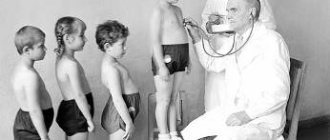Many future parents, before leaving for the countries of North America, namely the USA, think about the issue of compulsory vaccination of children, how to vaccinate in preventive or mandatory modes. Also, in accordance with US immigration law, every foreign citizen must provide documentation of completed immunizations for certain diseases.
Vaccinal prophylaxis is carried out with the consent of the parents, but has a number of features:
- for newborns, the vaccine is administered in the hospital after birth, and the first drug against hepatitis B is administered intradermally on the surface of the left shoulder;
- vaccination against tuberculosis is not carried out because the disease is considered defeated;
- After vaccinations, parents receive an immunization card in which all vaccinations are recorded.
What vaccines are given to children in the USA and CIS countries?
In America, in almost every state, children are immunized more actively than in the CIS countries, because more types of vaccines are introduced.
Children are actively administered immune drugs against rotavirus infectious diseases to prevent intestinal flu.
Every year they are required to vaccinate against chickenpox, and drugs against pneumococcal infection are administered four times. It is worth considering that children in the United States are vaccinated earlier.
The main vaccines for the first year of life are given starting from the second month of a baby’s life.
The main dangerous stage in the first year of vaccination for children is considered to be a complex drug to prevent mumps, measles and rubella. In Russia, a similar vaccine is divided into two.
Travel vaccinations
A separate line includes vaccinations that need to be done if you are going on a trip. From time to time, Rospotrebnadzor reports on outbreaks of infections abroad, but the most adequate and timely source remains the CDC website, which provides detailed information on different countries. If you are not traveling to Europe or North America, then we are talking about quite dangerous diseases - malaria, yellow fever, typhoid, rabies or encephalitis. There is a specific prevention against each of them, which significantly reduces the risk of becoming infected and getting sick.
Vaccines and special medications are not available in all private and public clinics, and the body requires at least a month to develop stable immunity to most pathogens, so vaccinations must be done in advance.
In addition, the CDC reports outbreaks of particularly dangerous infections and quarantines in certain areas. This could be a warning about an outbreak of Ebola or Marburg fever, or other situations associated with infections that threaten the life and health of tourists.
The situation in Venezuela
For a year now, the CDC website has posted a warning of the highest danger category for tourists going to Venezuela. Due to the economic crisis in the country, the health care system is no longer functioning, thousands of people suffer from diphtheria and measles, and the number of cases of malaria has reached four hundred thousand people.
US national vaccination calendar and similarities and differences with European countries and Russia
Based on data from the national vaccination calendar, most types of vaccines for certain diseases are actively administered in childhood in most countries, including the USA, Russia, and Europe.
The following diseases are subject to mandatory immunization:
- diphtheria, tetanus, whooping cough;
- measles, influenza, hemophilus influenzae infection;
- rubella, polio, mumps.
The United States is a distinctive feature among countries in hepatitis vaccination, because in other countries this vaccination is not included in the calendar of mandatory immunoprophylactic procedures.
Vaccination against tuberculosis is not given in all countries except Russia. The chickenpox vaccine is mandatory for children in the USA and Germany; in Russia, this practice began in 2015, as did the pneumococcal vaccine. In the USA, Germany and Great Britain, a vaccine against the papilloma virus is mandatory, but in the CIS countries this is not provided.
Among the countries of Europe, the CIS and North America, namely in the USA, vaccination includes the largest number of procedures to prevent a significant part of diseases, with the only exception being vaccination against tuberculosis.
Why don’t they vaccinate against these infections on a large scale in Russia or have they started recently?
In our country, it is believed that the risk of contracting meningococcal infection or Haemophilus influenzae is quite low, which means there is no point in getting vaccinated. Doctors in the USA believe otherwise - despite the rarity, infection with any of these pathogenic microbes leads to very serious consequences. All of them can cause pneumonia or meningitis, and the mortality rate even with timely treatment reaches 15%.
Two years ago, vaccination against Haemophilus influenzae was included in the domestic vaccination calendar, but only for children from risk groups (those with reduced immunity, for example, those with HIV).
Hepatitis A and rotavirus infection are not considered dangerous diseases: even if you get sick, with proper medical care, deaths or harm to health are practically excluded. In the USA, again, the approach is slightly different - hepatitis A and rotavirus are most often transmitted through nutrition (with food or water) if sanitation and hygiene standards are not observed. You could be vacationing in some godforsaken place, pick up rotavirus from eating street food or drinking raw water, and then spend a week in hospital due to dehydration. If a small child gets sick with rotavirus, then everything will be even more serious - without medical help, he can fall into a coma from dehydration within a day.
Human papillomavirus (HPV) is a relatively new vaccine that protects us not from the clinical manifestations of an infectious disease (which HPV may not have), but from the oncogenic effect of the virus. There are more than 100 types of the virus and it is very widespread - most people become infected with it soon after the start of sexual activity. Two types of viruses - 16 and 18 - were found to cause 70% of cases of cervical cancer, the second most common type of cancer among women living in developed countries. There are quite a few oncogenic types of the virus; at the moment there is a vaccine that protects against nine types - 6, 11, 16, 18, 31, 33, 45, 52 and 58. WHO recommends vaccination for girls 9–14 years old, since it is especially effective if infection with the virus has not yet occurred. In Moscow, the vaccine, according to WHO recommendations, was included in the vaccination calendar with a quadrivalent vaccine, which protects against four types of the virus, but other regions cannot yet afford these purchases. In the United States, they take into account that the virus can also cause cancer of the anus, vulva, vagina, penis and oropharynx. The CDC makes the following recommendations:
- vaccinate both boys and girls starting from the age of nine;
- increase the age limit for vaccination and recommends vaccinating women up to 26 years of age, and men up to 21 years of age, if routine vaccination has not been carried out previously;
- vaccinate at older ages for gays, bisexuals, transgender people and people with immunosuppression (if they were not vaccinated at an early age).
Americans use a vaccine that includes antigens to all nine strains of HPV. It has not yet been registered in Russia and it is impossible to officially vaccinate it.
The difference between the WHO and CDC recommendations relates to spending. Although HPV can cause cancer in men, the prevalence of these cancers is quite low, so overall the cost to the public would be significant and a small group in the general population would be protected. The US healthcare system can afford such costs, unlike many other countries.
The situation is similar with the flu vaccine - WHO recommends that everyone be vaccinated and do it annually, but in our country there is money for this only in the Moscow budget. Regions vaccinate free of charge only those at risk - pregnant women, children, students, medical workers and the military. Domestic vaccines are produced by several pharmaceutical companies, and as of 2021, only one of them, Ultrix, complied with WHO recommendations for strain composition - it contained 15 micrograms of each strain of inactivated virus. The rest of the domestic vaccines did not comply with the recommendations, while some were supplemented with additional immunostimulating drugs, whose effectiveness has not been proven internationally. There were great difficulties with imported vaccines that fully comply with WHO requirements last year, since the state did not purchase them, and small private batches were sold out in almost a few weeks in private clinics. When choosing a vaccine, it is best to focus on compliance of its composition with WHO recommendations. For the 2019–2020 season they have already been given; the vaccine must contain the following strains:
- an A/Brisbane/02/2018 (H1N1)pdm09-like virus;
- an A/Kansas/14/2017 (H3N2)-like virus;
- a B/Colorado/06/2017-like virus (B/Victoria/2/87 lineage); and
- a B/Phuket/3073/2013-like virus (B/Yamagata/16/88 lineage).
The strain composition of each vaccine is indicated in the instructions, in the “Composition” section. Instructions can be found on the Internet.
Vaccinations can only be done in medical institutions; a doctor cannot give them at your home, and you certainly cannot do them yourself. Vaccination against all these infections will have to be paid for, since they are not included in the national calendar. This is quite an expensive pleasure - most of the drugs are imported, so a complete set can cost several tens of thousands of rubles.

Prices for vaccination at Sechenov University
There are many vaccinations, so it makes sense to see an infectious disease specialist, rather than a general practitioner, to build a vaccination schedule taking into account the combination of medications, your chronic diseases, medical history and other circumstances. In addition, some medications may not be available at the clinic and will be specially ordered.
Mandatory vaccination to obtain a US visa and green card
To obtain a visa in an American country or change your status in order to obtain a residence permit, you must prove vaccination against a number of diseases:
- measles, mumps, rubella;
- polio, whooping cough, hepatitis B;
- tetanus, hemophilic influenza B;
- any other diseases on the recommendation of the advisory government body on immunoprophylaxis.
To apply for a green card or permanent residence permit in the United States, you must undergo a medical examination that has been approved by the State Department, and before your appointment with a physician, you must collect all the necessary documents, including medical records and vaccination certificates.
If certain types of vaccinations are missing when checking for compliance with vaccination requirements, then the required procedures must be completed to administer the drugs. You can get vaccinated from your doctor or before traveling abroad.
In any case, when completing the vaccination eligibility test, you must provide proof and complete all Form I-693 requirements.
Vaccinations without prior appointment. How is coronavirus vaccination going in New York?
Back in February, the basis for vaccination in New York became large-scale hubs - centers equipped in stadiums, concert halls and museums, where dozens of people can be vaccinated at once. One such center was created at the American Museum of Natural History near Central Park. In recent weeks, it has become one of the symbols of the fight against coronavirus. Vaccinations are given in one of the main halls of the museum under a huge life-size model of a blue whale. Photographs taken at this location are often used to illustrate stories about New Yorkers' struggles with the pandemic.
You can get to the center located in the museum directly from the metro. In the first hall, at two dozen tables, the data of those vaccinated is being recorded - whether the person has been sick in recent days, whether he has any allergic reactions. The whole procedure takes about five minutes; to complete it, you just need to present a driver’s license or any other document with a photo. If possible, proof of permanent residence in New York should be provided, but this may not be necessary. In the main hall where vaccinations are taking place, there are several dozen individual booths for vaccinations, and behind them there are 50 places to observe those who have just been vaccinated for 15 minutes. There are no queues with this organization. You can come at any time of the day or night, the center staff remind you when making an appointment for the second vaccination.
It was not possible to achieve this result immediately. “Now, of course, the procedure is organized very conveniently, but quite recently everything was not like that,” one of the women who came for vaccination told a TASS correspondent. “At that time, only older people could get vaccinated. I tried to record my mother several times, got up at five in the morning to do this, watched for the appearance of recording slots on the site, but I still couldn’t do it the first time.”
At the end of February, vaccination hubs like the one at the museum under the whale began to open, and the situation began to change. At some stage, queues became a problem. At the end of March, all residents of the city over 30 years of age were able to sign up for vaccination, and from the beginning of April - over 16. Even large centers were not always able to cope with the influx of applicants. “I signed up at the beginning of April, but I came, saw the line and decided that it would be better to come later,” said another visitor to the vaccination point. “But to be honest, I was probably just scared to get vaccinated.”
The path New York has traveled in two months can serve as an illustration of the approach to vaccination in the United States as a whole. If at the beginning of February it was almost impossible to get vaccinated, now it can be done in a minimum amount of time and without any difficulties. The return to use of the Johnson & Johnson vaccine, in accordance with the recommendations of the US Centers for Disease Control and Prevention, will apparently bring the pace of vaccination in the US to an even higher level. According to the federal US Centers for Disease Control and Prevention, more than 41.3% of the state population (over 137.2 million people) have received at least one dose of the coronavirus drug. Approximately 27.5% (91.1 million people) have been fully vaccinated.
CHICKEN POX
(chickenpox vaccine). The common name is chickenpox (or shingles); It is a highly contagious disease that causes a blistering rash on the body and scalp that gets worse over three to four days along with respiratory symptoms. In most cases, it does not cause much harm to healthy children, but it can be very serious for infants, older children and adults who have not had the disease (or have not been vaccinated), people with immunodeficiencies, and some children who are prone to eczema or are taking certain medications ( e.g. salicylates). Every year, almost 10,000 people are hospitalized with chickenpox and about 100 die. The illness lasts between seven and 21 days, and its long incubation period means children carrying the virus can pass it on to hundreds of people before anyone even knows they have it. Children should not attend daycare or school until they are completely no longer contagious. Pneumonia, serious skin infections, brain damage and other problems can make the disease worse. Unvaccinated women may give birth to babies who are at serious risk if they are exposed to chickenpox at an early age. The majority of the vaccinated population is protected from infection; those who do get sick experience a mild form of the disease.
Thousands of complaints
Now it’s not difficult to guess why De Niro’s film produced the effect of a bomb exploding in American society. In fact, publicly and with facts in hand, something was proven that until that moment had only been discussed by parents on Internet forums.
It should be noted that both Wakefield and Hooker, together with other scientists from different fields, were able to collect tens of thousands of evidence of complaints from parents whose children were harmed by MMR vaccination. All the parents talked about the same thing: the vaccination was given in the morning, the temperature rose in the evening, the next morning the child lost the ability to speak, navigate in space, stopped walking and became detached from the world, after which only therapy with the strongest antibiotics helped.
Russian pediatricians with whom Octagon was able to talk claim: even now, almost any research that differs from the CDC’s conclusions regarding the connection between diseases and vaccinations is recognized by world health organizations as unproven, and the doctors themselves are considered almost swindlers.
However, by 2000, Andrew Wakefield’s report, which he presented to the US Congress, contained more than 2,000 pages of conclusions and facts confirming the direct link between the vaccine and autism. After hearing the report, Congress ordered the CDC to investigate the issue to see if there really was a link between the disease and vaccines. Moreover, the main conclusion in the report of Wakefield and a group of scientists was a recommendation to abandon the triple vaccine in favor of single vaccines and continue the study of MMR.
It was at that moment that timid hope arose in society: maybe the US authorities would finally listen to the opinion of experts and draw conclusions? Conclusions were indeed drawn, although they were not at all what people expected.










